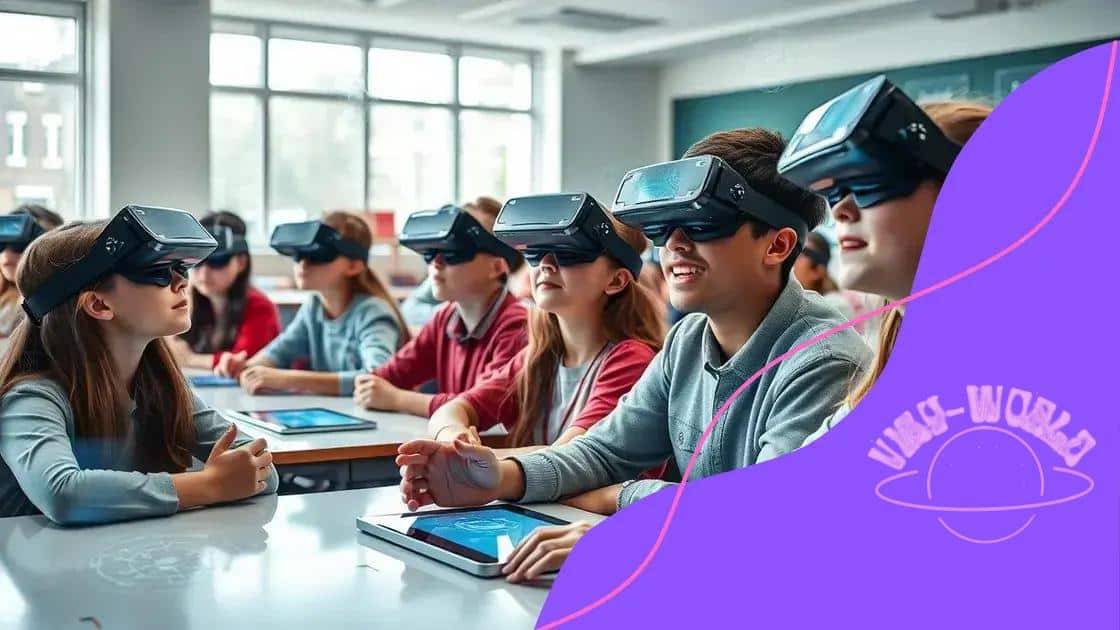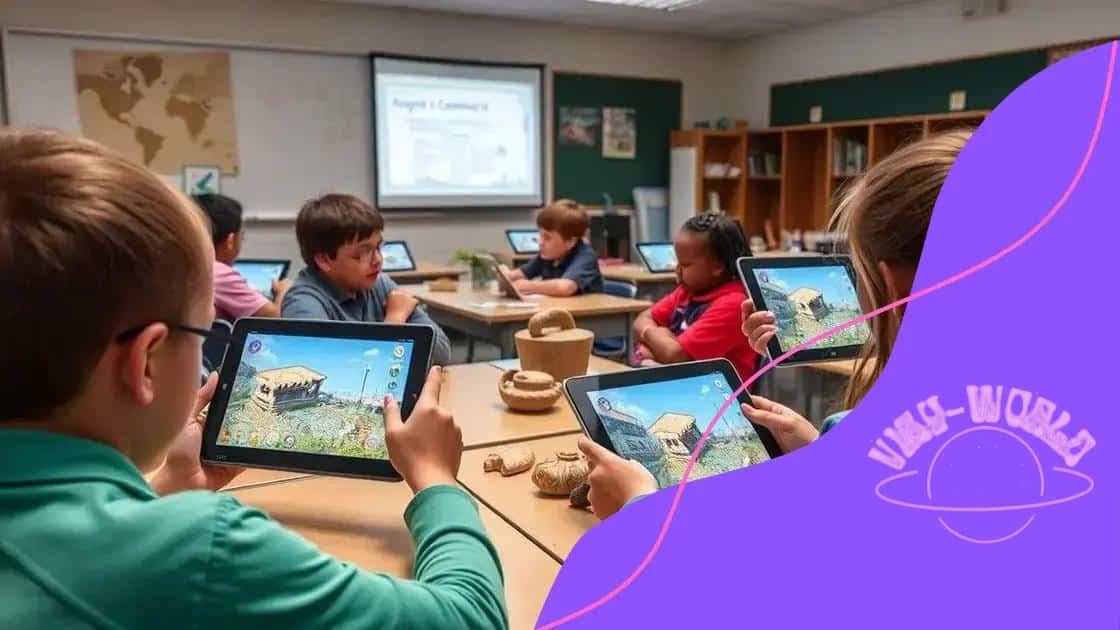How AR is being used for hands-on learning experiences

Augmented reality (AR) in education enhances learning by providing interactive, immersive experiences that engage students and promote personalized instruction while addressing challenges like technology costs and teacher training.
How AR is being used for hands-on learning experiences is transforming the way we engage with education. Have you ever considered how immersive technology can enhance your learning? Join us as we explore this fascinating intersection.
Understanding augmented reality in education
Understanding augmented reality in education is essential for grasping how it enhances learning. This technology combines the real world with digital information, creating immersive experiences that can elevate educational outcomes.
What is Augmented Reality?
Augmented reality (AR) is a technology that overlays digital content onto the physical world. Unlike virtual reality, which creates a completely digital environment, AR enriches your surroundings with pictures, videos, and animations. This makes learning not only interactive but also engaging.
Benefits of Using AR in Education
Implementing AR in classrooms has several advantages:
- Enhanced Engagement: Students are more likely to participate actively when they can interact with digital elements.
- Improved Retention: Visual learning helps students remember information better than text-based methods.
- Real-World Applications: AR allows students to see how concepts apply in the real world, making lessons more relevant.
For instance, in a science class, students can explore the human body by seeing 3D models in real time. This kind of experience helps them understand anatomy better than traditional textbooks. Moreover, AR resources are often accessible via smartphones or tablets, making them convenient for both teachers and students.
AR can also bridge the gap between theory and practice. Rather than just reading about concepts, students can visualize and manipulate them. When learning about geometry, for example, employing AR makes it easy to visualize complex shapes and formulas.
Challenges of AR Implementation
While augmented reality offers numerous benefits, there are also challenges schools face:
- Cost: The technology and resources required for AR can be costly for some educational institutions.
- Training: Teachers need proper training to integrate AR tools effectively into their lessons.
- Access: Not all students may have access to the hardware needed for AR experiences.
Despite these challenges, the potential of AR in education is monumental. By addressing these barriers, we can create a more inclusive and interactive learning environment.
Benefits of AR for hands-on learning
The benefits of AR for hands-on learning are significant and can transform education. By layering digital information onto the real world, students experience a more dynamic form of learning.
Engagement and Motivation
One of the primary advantages of augmented reality is that it enhances student engagement. When learners can interact with 3D models and simulations, they are more likely to take an active role in their education. This interactivity can motivate students to explore topics deeply and develop a greater interest in their studies.
Enhanced Understanding
Through AR, complex concepts become clearer. For instance, when studying physics, students can visualize forces and movements. Instead of just reading about how a pendulum swings, they can see it in action, making the information more relatable.
- Visual Learning: Seeing information represented visually helps learners grasp difficult concepts.
- Immediate Feedback: AR applications often provide instant feedback, allowing students to learn from their mistakes in real time.
- Collaboration: AR encourages teamwork as students can work together on projects and experiments.
Moreover, AR simulations can recreate real-world scenarios that are hard to replicate in the classroom. For example, anatomy students can dissect a virtual frog, gaining hands-on experience without the logistical constraints of a physical dissection. This not only enriches learning but also reduces waste and ethical concerns associated with real dissections.
Improved Retention and Critical Thinking
Research shows that interactive learning leads to better retention of information. With AR, students are not just passive recipients; they actively engage with the material. This engagement enhances their ability to remember and apply what they’ve learned.
Furthermore, AR promotes critical thinking skills. As students interact with digital content, they must analyze and apply knowledge. Exploring multiple perspectives in a 3D environment allows students to approach problems creatively. For instance, when learning about historical events, AR can immerse students in different time periods, fostering deeper understanding.
Examples of AR in classrooms

There are many exciting examples of AR in classrooms that showcase the power of this technology in enhancing learning experiences. These innovative uses help students grasp complex concepts and engage in their education more fully.
Virtual Field Trips
One popular application of AR is virtual field trips. With AR apps, students can explore historical sites, museums, or natural wonders without leaving the classroom. By pointing their devices at markers, they can see 3D reconstructions of ancient ruins or watch videos of wildlife in their habitats. This brings geography, history, and science to life.
Interactive Learning Materials
Textbooks and handouts can become more interactive with AR features. For example, students can scan images in their textbooks to access supplementary information or videos. Imagine reading about the solar system and instantly seeing a 3D model of the planets rotating before their eyes; this sparks curiosity and shows the content dynamically.
- Science Simulations: Students can conduct virtual experiments safely, such as chemical reactions or physics experiments, without the need for physical materials.
- Language Learning: AR can help language learners by providing contextual visuals. For example, scanning objects around the classroom could display their names in different languages.
- Art and Creativity: Students can use AR to create virtual art projects, layering digital images on physical canvases or exploring famous artworks in new ways.
Moreover, AR gaming in the classroom has proved beneficial. Educational games that use AR encourage teamwork and problem-solving. Students can participate in quests or challenges that require them to apply what they’ve learned to succeed.
Enhancing Special Education
AR tools can also support students with special needs. For example, visual aids through AR can help those with autism better understand social situations or improve communication skills. By creating scenarios in a controlled environment, students can practice skills they may find challenging.
The incorporation of augmented reality into classrooms is truly transforming how education is delivered. From virtual field trips to interactive texts and specialized programs, AR is making learning more accessible and engaging for all students.
Challenges of implementing AR
The challenges of implementing AR in education can be significant. While the potential benefits are enticing, various obstacles must be overcome to integrate augmented reality successfully.
Cost of Technology
One major challenge is the cost associated with AR technology. Schools may face expenses related to hardware, such as tablets and AR glasses, as well as software licenses for educational applications. This can strain already limited budgets, especially for underfunded districts.
Teacher Training
Another barrier is the need for adequate training for teachers. Educators must understand how to use AR tools effectively in classrooms. Without proper training, teachers may feel overwhelmed or uncertain about integrating technology into their curriculum, which can hinder its success in the learning environment.
- Time Constraints: Teachers already have tight schedules, and finding time to learn new technologies can be difficult.
- Curriculum Alignment: It can be a challenge to align AR activities with existing curriculum standards, making it hard to justify the time spent on new methods.
Additionally, educators require ongoing support to troubleshoot issues and enhance their skills as technology evolves. This creates a need for dedicated resources within schools.
Access and Equity Issues
Access to the necessary devices is another relevant concern. Not all students may have smartphones or tablets available to them. This creates disparities in learning experiences, as some students may benefit from AR while others are left out. Furthermore, internet connectivity can be a barrier, particularly in rural or low-income areas.
Addressing these challenges requires strategic planning and commitment from school administrations. They need to consider how to budget for new technology and prioritize effective training for teachers. Many districts also explore partnerships with tech companies to access discounted resources and support.
Potential Over-Reliance on Technology
Finally, there is a concern about over-reliance on technology in education. While augmented reality can enhance learning, it should not replace traditional teaching methods entirely. Balancing technology with hands-on experiences and face-to-face interactions is essential for developing well-rounded students.
The future of AR in educational experiences
The future of AR in educational experiences promises exciting possibilities that can transform learning environments. As technology continues to develop, AR is expected to play a significant role in how students engage with content.
Personalized Learning
One key trend is the move toward personalized learning. AR tools can adapt to individual students’ needs, allowing for customized educational experiences. For example, students struggling with a topic can access tailored activities that address their specific challenges, which can enhance their understanding and confidence.
Integration with Artificial Intelligence
Another important aspect is the integration of AR with artificial intelligence (AI). Combining these technologies can lead to smarter learning systems. AI can analyze student performance and offer immediate feedback through AR applications, providing additional resources or suggestions for improvement based on the learner’s needs.
- Enhanced Collaboration: As AR tools become more widespread, collaboration among students can increase. Group projects can incorporate AR, allowing students to work together on virtual activities.
- Real-World Applications: Students can engage in simulations of real-world scenarios that encourage critical thinking and problem-solving skills.
- Accessible Learning: As technology becomes more affordable, students from diverse backgrounds will have access to AR resources, making quality education more equitable.
Moreover, the evolution of mobile technology means that AR will become even more accessible. Students will likely use their smartphones to access educational AR experiences. This can enhance their learning at home and outside the traditional classroom setting, making it a more continuous and engaging process.
Implementation in Various Subjects
Future AR applications are expected to be implemented across various subjects. For instance, history lessons could allow students to experience historical events first-hand through augmented simulations. Science classes might enable students to visualize complex concepts like molecular biology in 3D.
Furthermore, as AR technology advances, the creation of user-friendly tools will empower teachers to develop their content, enriching the curriculum further. The potential for student-driven projects that utilize AR creates an exciting avenue for creativity.
In summary, the future of augmented reality in education is bright, with promises of personalized learning, enhanced collaboration, and innovative applications across subjects. Looking forward, students will benefit from a richer and more engaging educational experience.
In conclusion, augmented reality (AR) has a promising future in education. With its ability to create engaging, interactive experiences, AR enhances learning in many ways. It allows for personalized instruction, promotes collaboration among students, and makes learning accessible to everyone. By integrating AR with other technologies, like artificial intelligence, the educational landscape can become even more dynamic. As we move forward, the potential applications of AR in classrooms look bright, promising an exciting evolution in how students learn.
FAQ – Frequently Asked Questions about AR in Education
What is augmented reality (AR) in education?
Augmented reality (AR) in education is a technology that overlays digital content onto the real world, enhancing learning experiences through interactive and engaging activities.
How can AR improve student engagement?
AR can make learning more interactive by allowing students to visualize and interact with educational content, increasing their interest and motivation to learn.
What are some challenges of using AR in classrooms?
Challenges include the cost of technology, the need for teacher training, access to devices for all students, and ensuring that AR tools align with educational standards.
What does the future of AR in education look like?
The future of AR in education looks promising, with advancements in personalized learning, improved collaboration, and innovative applications that enhance the overall educational experience.





